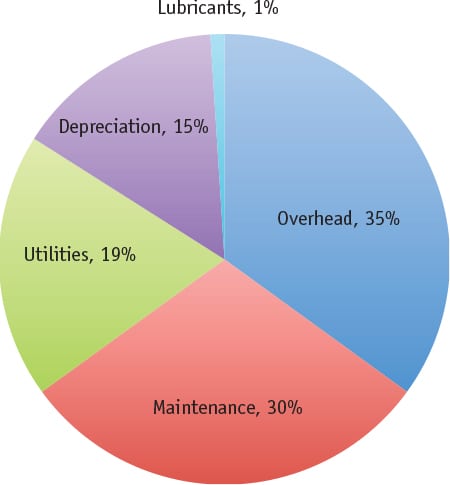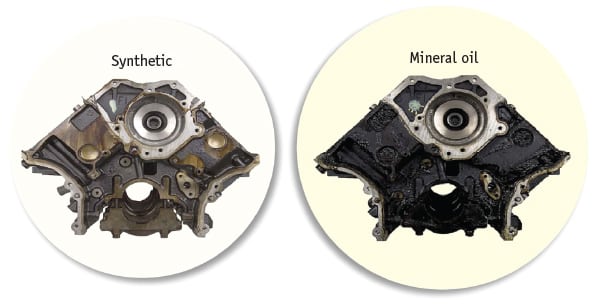Proper Lubrication Practices Improve Plant Operations
Although industrial lubricants typically account for only 1% of plant operational costs (Figure 1), the lack of proper lubrication products, techniques, or applications can have a much more severe effect on overall maintenance costs. One of the smallest items in the budget directly influences more than half of the total maintenance cost.
 |
| 1. The bottom line impact of lubrication. This chart shows an average breakdown of overall plant operating costs by category. Source: Hydrotex |
Lubrication has proven to be the most important factor regarding machinery reliability and productivity. The three major goals of operations and maintenance (O&M) are to improve output capabilities, reduce O&M costs, and increase profitability.
Many plant managers are looking for existing products or technologies combined to produce a synergistic outcome to create a significant advantage over the sum of their parts. Lubrication is one of the building blocks that can help achieve this goal. The proper lubricant, lubrication practices, training, and implementation of a lubrication management program (LMP) can reduce costs and improve productivity.
Synthetics Versus Minerals
Choosing the wrong lubricant for a machine component is more common than you may think in power generation facilities today. There is a big difference in performance between conventional mineral oil lubricants and synthetic lubricants.
Mineral oils break down under extreme heat and form deposits. While petroleum oils are produced to a high standard of purity, the fact remains that some unknown/unwanted content is still present. Because modern machines are built with higher operating speeds than ever before and produce more power, petroleum-based oils have reached a plateau.
Synthetic lubricants and greases have consistent properties and provide an array of overall performance improvements. Synthetics offer maximum protection for engines, gearboxes, motors, machines, and other moving parts because of their more consistent properties:
- Increased wear protection: Superior level of fluid film protection; high shear stability; and reduced scuffing, pitting, and rolling contact fatigue.
- Wide temperature range: Maintain fluid film protection at higher temperatures; lower pour points and greater fluidity at low temperatures.
- Longer oil life: Free of unstable molecules that are prone to degradation; extend oil drain intervals; higher resistance to oxidation.
- Improved bottom line: Optimize equipment performance and reduce maintenance costs.
The additive chemistry in synthetics widens the operational temperature range, extends drain intervals, and provides a protective barrier on equipment against outside contaminants and corrosion. Synthetics typically have extended drain intervals due to their oxidation resistance. Increased oxidation resistance translates into deposit control and longer oil and grease life. Note the darker, thicker buildup in the engine operated with mineral oil on the right in Figure 2, compared to the cleaner engine on the left, which used synthetic oil.
Many people do not understand the difference between initial price and overall costs when comparing synthetic and mineral oil–based lubricants and greases. Often, the lubricant with the lowest initial price is selected over another that will provide sustainable long-term results and overall cost-savings.
The leading benefits of synthetics and specially designed lubricants are their ability to reduce waste, increase equipment life, and reduce energy consumption while improving productivity, sustainability, profitability, and carbon footprint.
Energy efficiency can be achieved with synthetics by reducing friction, which lowers power consumption. When evaluating operating costs, especially with heavy machinery, energy consumption is a critical component. Proper lubrication with the correct lubricant can reduce energy usage by as much as 10%.
Fit for Purpose
There is no such thing as a one-size-fits-all lubricant or grease. The correct lubricant is always application-driven. A lubricant must be fit for purpose. When selecting the correct lubricant, viscosity is one of the most important factors and must match the load, environment, temperature (both ambient and operational), and speed (LETS) of the component or equipment.
Viscosity affects a fluid’s ability to flow between two surfaces and how it resists being squeezed away from the surface while experiencing load and pressure. When addressing LETS to determine the proper viscosity lubricant or grease to use in a power plant, the following aspects should be considered:
- Load: Determine the design load for a specific application and compare it to the load that is currently being exerted on the machine. Sometimes, key factors have changed. For example, if the weight of material being carried on a conveyor has changed, it could significantly affect the loading on the bearings, idlers, and motor.
- Environment: “Cleanliness is next to godliness” when it comes to filtration and the prevention of corrosion and contaminants in equipment. To ensure the quality of a lubricant is maintained, cleanliness is a very important qualitative parameter.
- Temperature: Synthetic and multi-viscosity grade lubricants provide temperature flexibility in high or low operating temperatures.
- Speed: High- and low-speed components require the correct viscosity lubricants and greases to enter and reside within the contact-friction area.
Selecting a lubricant is a complex process that requires knowledge of both the machines and the lubricants. A critical part of choosing a lubricant is deciding to go with a synthetic or mineral base. In general, synthetics will have more sustainable properties than mineral oils. However, you will not get the full benefit of any lubricant, especially a synthetic lubricant, unless you know how to use it correctly.
Knowledge Is Essential
Lubricants of high performance and quality, at any price, will not be valuable without the correct training and education. Training and continuing educational programs are vital for facilities to gain an understanding of lubrication fundamentals.
A case study performed by the Institute of Mechanical Engineers revealed that 43% of machine failures could be attributed to the incorrect choice and usage of lubricants. Most people still believe that machine failure is a “unique event.” However, failure is a “process.”
Lubrication training focuses on the “what,” “why,” and “how,” so that friction and wear can be minimized. That way the people “who” are responsible for maintenance can take timely action during the process to extend the life and precision of equipment.
Understanding lubrication fundamentals can reduce maintenance expenses more than 30% by ensuring the proper lubrication and LMP is implemented. Lubrication education and training teaches staff how to develop a successful LMP and proactive maintenance program, which improves reliability at the lowest cost.
Without the knowledge of lubrication attributes, it is more difficult to establish an LMP. A complete and successful LMP should include continuing education and training; equipment and application surveys; knowledge of the product, equipment, and lubrication storage conditions; and a proactive maintenance program that includes oil analysis testing.
Begin with the End in Mind
The main reasons for setting up an LMP are to prevent unplanned downtime from equipment failure; increase output capability, profitability, productivity; and reduce the carbon footprint. An LMP should define an objective that “begins with the end in mind.”
A program capable of defining and controlling the entire lubrication process proactively through condition-based monitoring (CBM) techniques will ultimately increase productivity and reliability. The first tenet in an LMP is to understand that lubricants are application-specific. Knowing how to properly use the lubricant is just as valuable as the lubricant itself. Poor lubrication techniques and processes will likely lead to shortened equipment life and unforeseen outages at the worst possible time, such as in the middle of the peak summer season.
Equipment and application surveys are the next step in an LMP to provide facilities a clear picture of existing lubrication practices and maintenance procedures. The initial plant survey and lubrication audit becomes the foundation for the entire LMP and sets expectations.
Implementation of CBM will compare historical data and trends against engineering facts to detect, highlight, and analyze potential problems before they occur. The key to this approach is that once the root issue has been defined, corrective action can and should be taken when it is most advantageous for the user. Oil analysis is another part of the baseline information included in an LMP to help identify potential equipment concerns and track trends following lubrication changes.
In power plants today, parameters are far less predictable and static than in the past due to frequent load changes resulting from solar and wind generation. Given that reality, how can an LMP and training help staff control for those variations in operating conditions? Knowledgeable plant personnel trained in lubrication fundamentals will be able to identify a potential problem rather than experiencing equipment failure.
It is not enough for management to agree with implementing the correct lubrication practices. Rather, all staff operating and managing the equipment need lubrication knowledge. Training will be even more important in the future as experienced personnel retire, and as multifunctional or cross-trained personnel perform different functions.
Lubrication Planning and Predictive Maintenance
Every facility plans downtime for routine maintenance, equipment rebuild, plant expansions, and other reasons. Planned downtime is designed to ensure equipment is maintained and production goals are met. Lubrication-related downtime can be caused by:
- Low-grade/commodity lubricants
- Under- or over-lubrication
- No lubrication
- Using the wrong lubricant
- Missed lubrication cycles
- Excessive wear
- Increased operational temperatures
- Contamination of oils and greases
- Seal damage
- Compatibility problems
- Leaks
These are just some of the problems every facility can experience.
Planning is a key part of proper lubrication management. There are three basic types of maintenance: corrective (fix what just failed), preventive (fix on a time-based frequency whether it needs it or not), and predictive (monitor the equipment to see if the data shows that an item is moving toward failure and make repairs just before it fails).
Many successful companies are changing to predictive maintenance programs, focusing on oil analysis, vibration analysis, thermography, and fluid and system cleanliness to improve the reliability of equipment. They can then perform maintenance at the optimum time, rather than on some arbitrary schedule. Paying attention to monitoring the details is measurement-driven and deploys data analysis to make risk-informed decisions. Proper lubrication practices not only require knowledge but also a proactive approach.
Ask the Experts
Overall, lubricants make up a small portion of O&M costs, but improper usage and choosing the wrong lubricant affects the bottom line and business operating profits. Making sure that fundamental lubrication practices are being handled correctly has huge benefits over time. If sustainable operations are the goal, proper lubrication practices and an LMP can help achieve a reliable, cost-effective plant operation.
Making a big decision can be easier with the help of a professional. Lubrication is a specialty; becoming an expert requires education and experience. Though there are many distributors to choose from, Hydrotex is one company that offers LMPs and on-site training presented by knowledgeable lubrication consultants. The key to success is finding a company that not only can recommend the right high-performance lubricants for the applications but also can recommend reliability solutions. Focus on the overall solution tailored to fit your goals. ■
—John Bickley, PE is the vice president of sustainable utility sales for Hydrotex.
